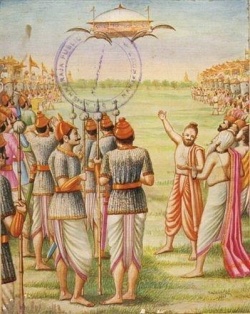Difference between revisions of "Ancient Flying Machines"
(Created page with "thumb|250px| <poem> Introduction Flight has been the dream of humankind since they watched in awe as birds soared effortlessly through the sky. But...") |
|||
| Line 3: | Line 3: | ||
Introduction | Introduction | ||
| − | Flight has been the dream of humankind since they watched in awe as birds soared effortlessly through the sky. But, according to accepted history, it wasn't until the 1780s that two Frenchmen achieved lighter-than-air flight when they were lifted into the air in a hot air balloon near Paris. Then powered, heavier-than-air flight became the goal. And although it was theorized that heavier-than-air flight was possible as early as the 13th century, and in the 16th century Leonardo da Vinci designed winged aircraft and a crude kind of helicopter, it wasn't until the Wright brothers made their first successful flights at Kitty Hawk in 1903 that powered flight became a reality. | + | Flight has been the [[dream]] of humankind since they watched in awe as birds soared effortlessly through the sky. But, according to accepted history, it wasn't until the 1780s that two Frenchmen achieved lighter-than-air flight when they were lifted into the [[air]] in a [[hot]] [[air]] balloon near {{Wiki|Paris}}. Then powered, heavier-than-air flight became the goal. And although it was theorized that heavier-than-air flight was possible as early as the 13th century, and in the 16th century Leonardo da Vinci designed winged aircraft and a crude kind of helicopter, it wasn't until the Wright brothers made their first successful flights at Kitty Hawk in 1903 that powered flight became a [[reality]]. |
| − | That's the widely accepted history. Some researchers and a few rogue scientists believe there's evidence to suggest that humans achieved flight earlier in history - much earlier... so early, they say, that the knowledge of this technology has been lost and ancient stories that recount adventures of human flight have been relegated only to myth. | + | That's the widely accepted history. Some researchers and a few rogue [[scientists]] believe there's {{Wiki|evidence}} to suggest that [[humans]] achieved flight earlier in history - much earlier... so early, they say, that the [[knowledge]] of this technology has been lost and [[ancient]] stories that recount adventures of [[human]] flight have been relegated only to [[myth]]. |
| − | Is it possible that humans developed the technology to fly in early civilizations - or in civilizations that are now lost to history? Let's take a look at what some call the evidence - intriguing artifacts, carvings, inscriptions and legends - that they say point to the true record human of flight. | + | Is it possible that [[humans]] developed the technology to fly in early {{Wiki|civilizations}} - or in {{Wiki|civilizations}} that are now lost to history? Let's take a look at what some call the {{Wiki|evidence}} - intriguing {{Wiki|artifacts}}, carvings, {{Wiki|inscriptions}} and {{Wiki|legends}} - that they say point to the true record [[human]] of flight. |
</poem> | </poem> | ||
{{R}} | {{R}} | ||
Latest revision as of 09:55, 7 January 2015
Introduction
Flight has been the dream of humankind since they watched in awe as birds soared effortlessly through the sky. But, according to accepted history, it wasn't until the 1780s that two Frenchmen achieved lighter-than-air flight when they were lifted into the air in a hot air balloon near Paris. Then powered, heavier-than-air flight became the goal. And although it was theorized that heavier-than-air flight was possible as early as the 13th century, and in the 16th century Leonardo da Vinci designed winged aircraft and a crude kind of helicopter, it wasn't until the Wright brothers made their first successful flights at Kitty Hawk in 1903 that powered flight became a reality.
That's the widely accepted history. Some researchers and a few rogue scientists believe there's evidence to suggest that humans achieved flight earlier in history - much earlier... so early, they say, that the knowledge of this technology has been lost and ancient stories that recount adventures of human flight have been relegated only to myth.
Is it possible that humans developed the technology to fly in early civilizations - or in civilizations that are now lost to history? Let's take a look at what some call the evidence - intriguing artifacts, carvings, inscriptions and legends - that they say point to the true record human of flight.
